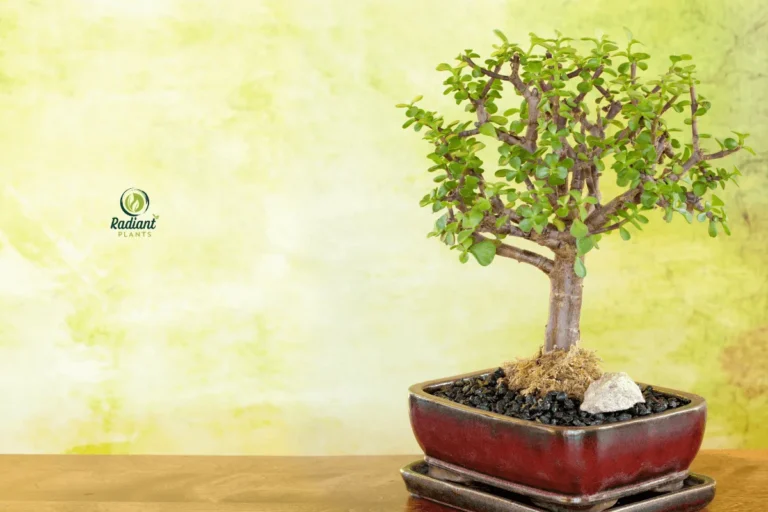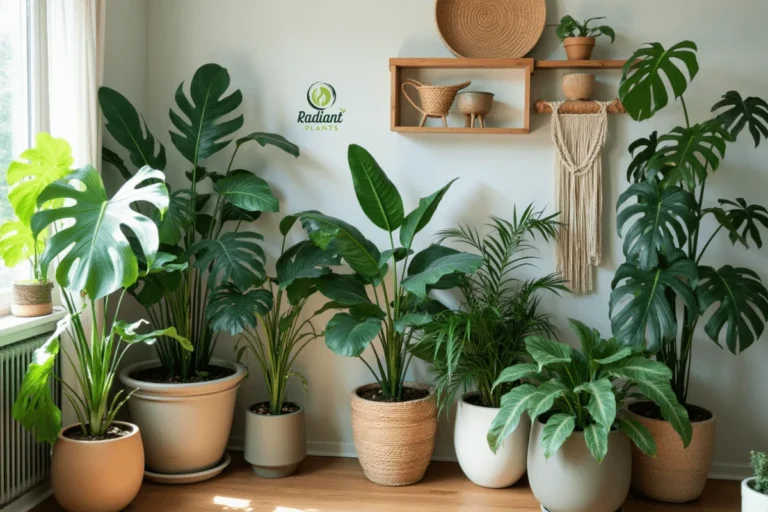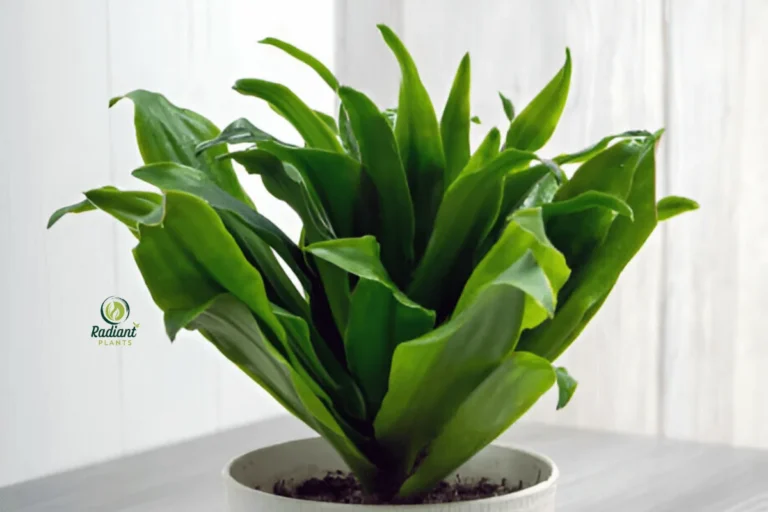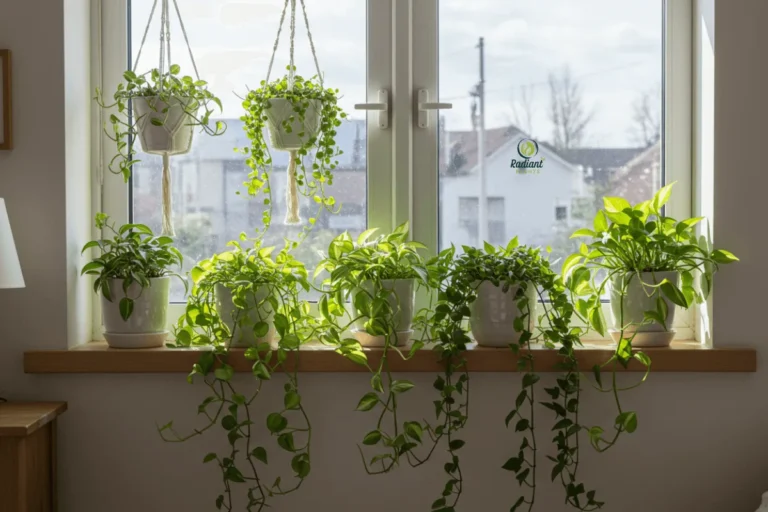Plants With Big Leaves: Bold Picks for Stunning Spaces
If you want to elevate your space instantly, plants with big leaves are the quickest way to create a bold, modern, and naturally luxurious atmosphere. These dramatic houseplants capture attention with their sweeping foliage, sculptural shapes, and lush textures—making them perfect for anyone who wants their greenery to make a real statement.
In this guide, you’ll explore the most stunning plants with big leaves for indoor spaces, from iconic Monsterras to elegant Birds of Paradise and velvety Alocasias. You’ll learn how big these plants can actually grow, how to care for them so their oversized leaves stay glossy and healthy, and how to style them beautifully in any room. We’ll also cover common mistakes to avoid and simple propagation methods to expand your collection.
Whether you’re building a full indoor jungle or just want one striking focal point, plants with big leaves offer endless ways to transform your home into a lush, calming retreat.
Let’s dive in and discover the best bold-leaf beauties for your space.
Table of Contents
Table of Contents
Why Big-Leaf Indoor Plants Transform Your Space
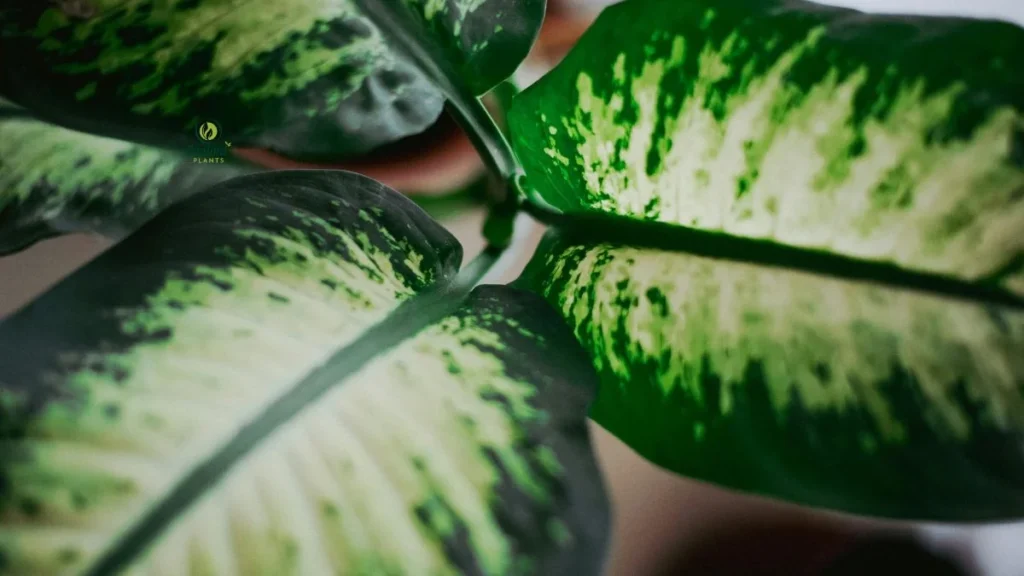
There’s a reason plants with big leaves dominate interior design magazines and modern home styling guides: they completely change the energy of a room. Their oversized, sculptural foliage creates an instant focal point, adding height, texture, and movement in a way small plants simply can’t match. When you bring indoor plants with big leaves into your home, you’re not just adding greenery—you’re shaping the atmosphere.
One of their strongest advantages is how effortlessly they fill empty corners. Large-leaf tropical indoor plants like Monstera deliciosa or Bird of Paradise visually “anchor” a space, making a room feel more complete and intentional. Designers often use statement houseplants for this very reason: their bold silhouettes soften hard lines, balance tall furniture, and introduce organic shapes that elevate any aesthetic—from minimalist to boho to luxurious modern.
Beyond beauty, big-leaf plants offer meaningful wellness benefits. Studies in environmental psychology show that large foliage enhances biophilic design by strengthening your sense of connection to nature. This can reduce stress, improve concentration, and boost overall mood. Many tropical indoor plants also excel at air purification, thanks to their broad leaf surface area that absorbs pollutants more efficiently.
So, why do some indoor plants have big leaves? In nature, tropical species evolved oversized foliage to capture more sunlight in dense, shaded rainforests. Indoors, this adaptation translates into dramatic, lush greenery that thrives in bright, indirect light.
For styling ideas, you can explore guides such as “Easy Ways to Style Your Cane Plant in Any Room” or “How to Incorporate Red Plants into Your Interior Spaces“—both perfect complements to big-leaf décor.
Big, bold, and beautifully architectural, these plants do more than decorate—they transform your space into a vibrant, calming retreat.
Best Indoor Plants With Big Leaves (Top Picks)

If you’re wondering, “What indoor plant has the biggest leaves?”, the truth is that several stunning species compete for the title. These large-leaf houseplants bring bold textures, lush indoor foliage, and sculptural beauty to any space. Here are the top picks every plant lover should consider.
Monstera Deliciosa
One of the most iconic big leaf indoor plants, the Monstera Deliciosa produces massive split leaves that can reach over 2 feet wide indoors. It’s fast-growing, adaptable, and thrives in bright, indirect light. Monstera are excellent for beginners thanks to their forgiving nature. Their aerial roots and fenestrations give them a tropical, architectural look perfect for modern homes.
Monstera Varieties: The Ultimate List for Indoor Jungle Lovers
Philodendron ‘Splendid’
This hybrid Philodendron is known for its velvety, heart-shaped leaves that mature into impressively large foliage. It thrives in medium to bright indirect light and high humidity. The ‘Splendid’ offers a luxurious texture that instantly elevates any plant corner. For in-depth guidance, visit Everything You Need to Know About Philodendron Splendid Care on RadiantPlants.com.
Why Philodendron Imperial Red Is the Perfect Low-Maintenance Houseplant
Fiddle Leaf Fig (Ficus lyrata)
Fiddle Leaf Figs are statement houseplants famous for their violin-shaped leaves that can grow up to 18 inches long. They’re ideal for tall ceilings or empty corners. While a bit finicky, they reward consistent care with dramatic, glossy foliage that transforms living rooms and entryways.
Alocasia Polly or Alocasia Frydek
Alocasias are loved for their striking arrow-shaped leaves and bold veining. Frydek, in particular, showcases velvety, deep-green foliage that appears almost sculptural. They prefer warm temperatures, high humidity, and evenly moist soil.
Bird of Paradise (Strelitzia reginae)
If you love tropical vibes, this plant is unbeatable. Bird of Paradise develops long, paddle-shaped leaves resembling banana plants. Indoors, its leaves can reach up to 3 feet long, making it one of the top contenders for the largest indoor foliage.
Dieffenbachia (Dumb Cane)
Dieffenbachia is a hardy houseplant with broad, patterned leaves that brighten any room. Its foliage can grow over a foot long, and it tolerates lower light better than many big-leaf varieties. Perfect for beginners seeking lush greenery.
Calathea Orbifolia
Known for its round, silver-striped leaves, Calathea Orbifolia adds refined elegance to any interior. It thrives in moderate humidity and filtered light. Its broad leaves create a soft, cascading silhouette.
Rubber Plant (Ficus elastica)
Rubber Plants are reliable growers with thick, glossy leaves that reach up to 12 inches. They adapt well to indoor environments and tolerate lower light, making them a versatile choice for apartments or offices.
For more Philodendron varieties with stunning foliage, explore Thriving Made Simple with Philodendron Brasil Care Guide on RadiantPlants.com.
How Big These Indoor Plants Actually Get

One of the most exciting parts of growing plants with big leaves is watching just how dramatic they can become indoors. While houseplants typically remain smaller than their outdoor counterparts, many are still capable of producing impressive leaf sizes and heights when given the right conditions.
Leaf size varies widely between species. Monstera deliciosa leaves can reach 18–24 inches indoors, while Bird of Paradise foliage commonly grows 2–3 feet long. Fiddle Leaf Fig leaves average around 12–18 inches, and Alocasia varieties like Frydek or Polly typically reach 8–12 inches across, depending on humidity and light. Rubber Plants, although known for their thick texture rather than width, still produce leaves around 10–12 inches long.
Indoors, most large-leaf houseplants reach between 3 and 8 feet tall. For example, an indoor Monstera may top out at 6–7 feet, while a Bird of Paradise can reach 7 feet if given bright, consistent light. Outdoor versions, by contrast, can become significantly larger—sometimes double the height—due to stronger sunlight and higher humidity.
If you’re asking, “What indoor plant grows huge leaves quickly?”, Monstera, Birds of Paradise, and fast-growing Philodendrons are your best choices. Their indoor growth rate is naturally faster due to vigorous root systems and robust tropical genetics.
To achieve bigger, fuller leaves indoors, focus on three essentials: bright indirect light, consistent humidity (around 50–60% for tropical species), and a nutrient-rich, well-aerated soil mix. Regular fertilizing during the growing season can boost leaf size, while wiping dust off broad foliage keeps photosynthesis efficient.
For additional indoor plant inspiration, explore Croton Plant Care Tips for a Vibrant, Healthy Plant or learn how fast growers behave in Dragon Tail Plant Care: The Ultimate Guide on RadiantPlants.com.
Care Tips for Indoor Plants With Big Leaves
Caring for plants with big leaves is both rewarding and straightforward once you understand their specific needs. Large-leaf houseplants aren’t just visually striking—they also require attention to light, water, and humidity to maintain their lush foliage.
Light: Bright, indirect light is essential for these tropical beauties. Insufficient light can cause leaves to stay small or develop pale, uneven coloring. Position plants near east- or south-facing windows, but avoid direct sunlight, which can scorch their oversized leaves.
Water: Big leaves naturally lose more moisture through transpiration, meaning these plants often need more frequent watering than smaller-leaf species. Keep soil consistently moist but never soggy to prevent root rot. A well-draining pot and soil mix are crucial to maintain healthy roots.
Humidity: Many tropical indoor plants evolved in humid environments. Aim for 50–60% humidity using a humidifier, pebble trays, or grouping plants. Proper humidity keeps leaf edges from browning and promotes fuller growth.
Soil Mix & Fertilizing: Choose an airy, nutrient-rich potting mix with organic matter to encourage strong, fast-growing foliage. During the growing season, feed big-leaf houseplants every 4–6 weeks with a balanced liquid fertilizer to support leaf development and overall vitality.
Cleaning Leaves: Dust can block light absorption and reduce photosynthesis, especially on large leaves. Wipe them gently with a damp cloth or give occasional showers to keep them glossy and healthy.
Wondering, “Are big leaves good for indoor plants?” Absolutely—they help maximize photosynthesis, enhance air quality, and add dramatic visual appeal. To prevent common problems like yellowing or fungal issues, refer to White Spots on Plant Leaves? Don’t Panic—Fix Them Now and Root Rot Treatment: 7 Proven Ways to Stop the Spread for in-depth solutions.
With consistent attention to light, water, humidity, and nutrition, your large-leaf houseplants will thrive, producing bold, vibrant foliage that transforms your indoor space.
Styling Ideas With Big-Leaf Houseplants
Plants with big leaves are not just greenery—they’re living décor that can transform your home with texture, color, and presence. Their bold foliage makes them natural focal points, ideal for drawing the eye to empty corners or highlighting architectural features in a room.
Pairing large-leaf plants with tall planters is a simple trick to emphasize height and create a sense of scale. For example, a Fiddle Leaf Fig in a sleek, modern planter instantly elevates a living room corner, while a Monstera in a woven basket adds warmth and a tropical feel.
Contrast is key when styling. Combine big-leaf plants with trailing varieties like Pothos or Philodendron for layered visual interest. This mix adds depth and creates a lush, indoor jungle aesthetic without overcrowding the space.
Placement matters: living room corners, entryways, and reading nooks are perfect spots to showcase statement foliage. Not only do these locations receive adequate light, but they also allow the plant to act as a natural divider or accent piece.
Consider color and texture when coordinating with furniture. Deep green leaves complement neutral interiors, while variegated plants add a playful pop of contrast. Mixing leaf shapes and patterns can create a curated, designer look that feels intentional yet natural.
For more styling inspiration, check out Easy Ways to Style Your Cane Plant in Any Room or explore bold contrasts with Top 10 Indoor Variegated Plants to Brighten Up Your Space on RadiantPlants.com.
With thoughtful placement and styling, your big-leaf houseplants won’t just fill space—they’ll bring life, drama, and personality to every corner of your home.
Common Mistakes With Indoor Big-Leaf Plants
Caring for plants with big leaves is rewarding, but even experienced plant lovers can make mistakes that affect their health and appearance. Understanding these pitfalls ensures your houseplants stay lush, vibrant, and thriving.
Overwatering is the most common mistake. Large-leaf plants like Fiddle Leaf Figs or Monstera lose a lot of moisture through their foliage, so it’s easy to assume they need constant watering. In reality, soggy soil can lead to root rot, yellowing leaves, and stunted growth. To avoid this, check soil moisture with your finger or a moisture meter and always use well-draining soil. For in-depth solutions, see Root Rot Treatment: 7 Proven Ways to Stop the Spread.
Insufficient light is another frequent issue. When these tropical indoor plants don’t receive bright, indirect light, their leaves may remain small, pale, or develop brown edges. Placing your plants near east- or south-facing windows, or supplementing with grow lights, can help them flourish.
Low humidity can also stress large-leaf houseplants. Dry indoor air often causes leaf edges to brown or curl. Using a humidifier, misting leaves, or grouping plants helps maintain a more tropical environment.
Finally, not cleaning dust from large leaves can reduce photosynthesis and make your plants look dull. Wiping leaves gently with a damp cloth every few weeks ensures they stay glossy and healthy.
If you encounter pests or leaf damage, check How to Get Rid of Aphids: 5 Mistakes to Avoid for practical guidance.
By addressing overwatering, light, humidity, and cleanliness, you can prevent yellowing leaves, crispy edges, and stunted growth—ensuring your plants with big leaves remain the dramatic, thriving focal points they were meant to be.
Propagation Methods for Big-Leaf Indoor Plants
Yes, you can propagate large-leaf indoor plants, and doing so is a rewarding way to expand your indoor jungle or share plants with friends. Different species respond best to specific propagation methods, so understanding the options ensures success.
Stem Cuttings: This is one of the most popular methods for plants with big leaves, like Monstera and Philodendron. Choose a healthy stem with at least one node and place it in water or moist soil. Within a few weeks, roots begin to develop, and baby leaves start to unfurl. This method is simple, effective, and ideal for beginners. For detailed guidance on Philodendrons, check out Philodendron Red Congo Care.
Air Layering: Fiddle Leaf Figs and Rubber Plants respond well to air layering. This technique involves wounding a stem, wrapping it with moist sphagnum moss, and covering it to encourage root growth while the stem is still attached to the parent plant. Once roots are established, the new plant can be safely cut and potted.
Rhizome Division: Alocasia and other tuberous species are propagated through rhizome or root division. Carefully separate the rhizomes, ensuring each section has a growing point, and plant them in well-draining soil. This method is excellent for rapidly increasing your collection.
Growing Baby Leaves into Mature Foliage: After propagation, young leaves may appear smaller than mature ones. Provide bright, indirect light, proper humidity, and regular fertilization to encourage full-size growth. Patience and consistent care are key.
For broader propagation inspiration and indoor plant tips, see Night-Blooming Jasmine Care Guide.
By mastering these methods, you can expand your collection of big-leaf indoor plants and enjoy the satisfaction of nurturing new foliage from tiny beginnings.
FAQs for plants with big leaves
What is the name of the plant with big leaves?
Several indoor plants are famous for their oversized foliage. Popular options include Monstera deliciosa, Fiddle Leaf Fig (Ficus lyrata), Philodendron Splendid, and Alocasia Polly. These species are prized for their dramatic, broad leaves that instantly elevate indoor spaces. For care tips, see Philodendron Red Congo Care on RadiantPlants.com.
What is the largest leaf of a plant?
The Raphia palm holds the record for the largest leaf in the plant kingdom, with fronds reaching up to 80 feet in length outdoors. Indoors, large-leaf houseplants like Bird of Paradise and Monstera deliciosa produce leaves up to 2–3 feet long, creating a tropical, statement-making effect without requiring outdoor space.
What indoor plant has the biggest leaves?
For indoor spaces, Monstera deliciosa, Bird of Paradise, and Fiddle Leaf Fig are top contenders for the largest leaves. These plants thrive in bright, indirect light and humid conditions, producing bold, broad foliage that serves as a natural focal point. Learn styling ideas in Easy Ways to Style Your Cane Plant in Any Room.
What are examples of plants with broad leaves?
Examples of broad-leaf houseplants include Calathea Orbifolia, Alocasia Frydek, Dieffenbachia, and Rubber Plant (Ficus elastica). Their wide leaves not only enhance photosynthesis but also add texture, depth, and lush greenery to interiors, making them ideal for statement corners or grouped displays.
How do you care for plants with big leaves indoors?
Proper care includes bright, indirect light, regular watering without waterlogging, high humidity, and nutrient-rich soil. Cleaning dust from large leaves ensures efficient photosynthesis. Avoid common mistakes like overwatering or placing them in low light. For problem-solving tips, see White Spots on Plant Leaves? Don’t Panic—Fix Them Now.
Plants with big leaves are more than just decorative greenery—they’re living statement pieces that bring drama, texture, and a sense of calm to any indoor space. From Monstera deliciosa to Fiddle Leaf Figs and Alocasia varieties, these lush houseplants not only elevate your décor but also improve air quality, boost mood, and create a natural, tropical ambiance.
Caring for them is simple when you follow a few key tips: provide bright, indirect light, maintain consistent moisture without overwatering, ensure adequate humidity, and keep their leaves clean for optimal photosynthesis. Regular fertilizing during the growing season and attention to placement will encourage bold, healthy foliage that thrives year after year.
Ready to add a bold touch to your home? Start with a statement plant that fits your space and style, and watch it transform your interior into a vibrant, calming oasis. Explore our in-depth guides on related houseplants like Philodendron Splendid and Croton to expand your indoor jungle and learn expert care strategies.
Bring the beauty and power of big-leaf indoor plants into your home today—you’ll be amazed at how much life and personality they add.


